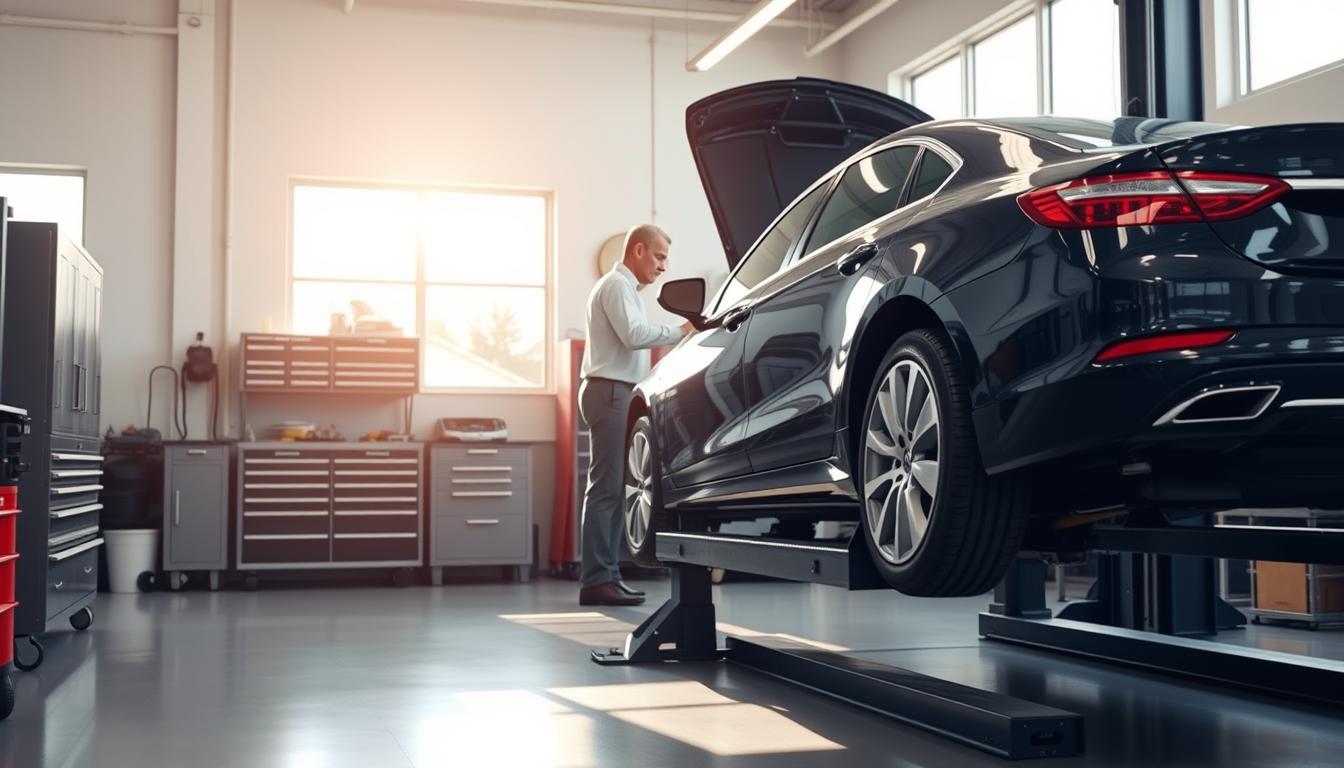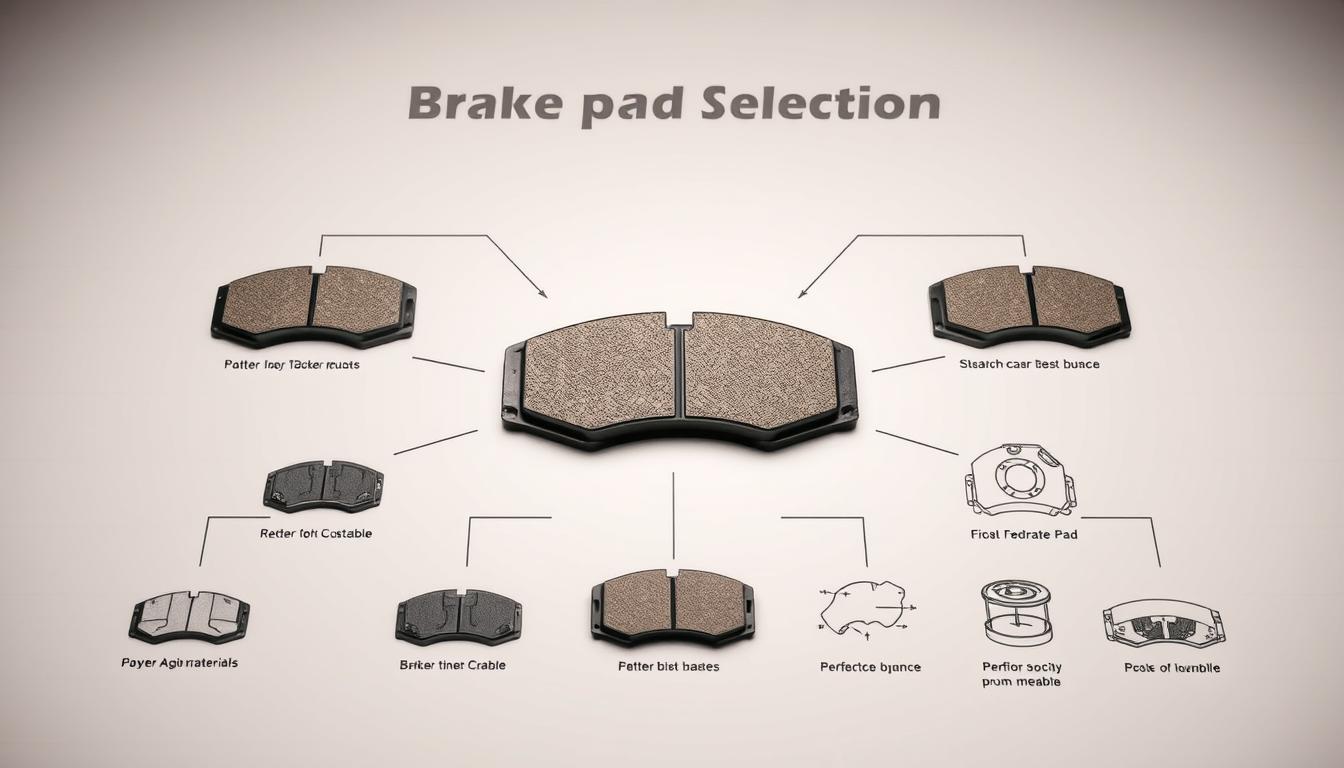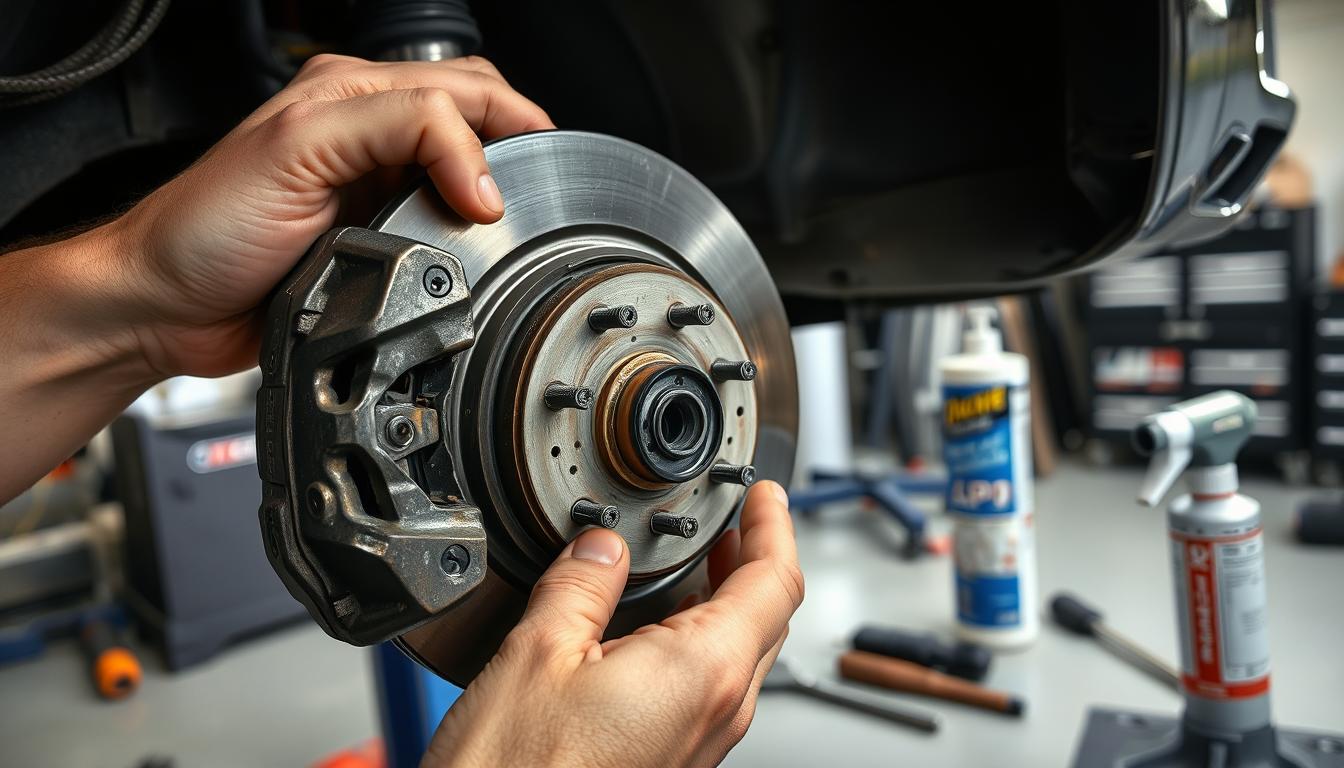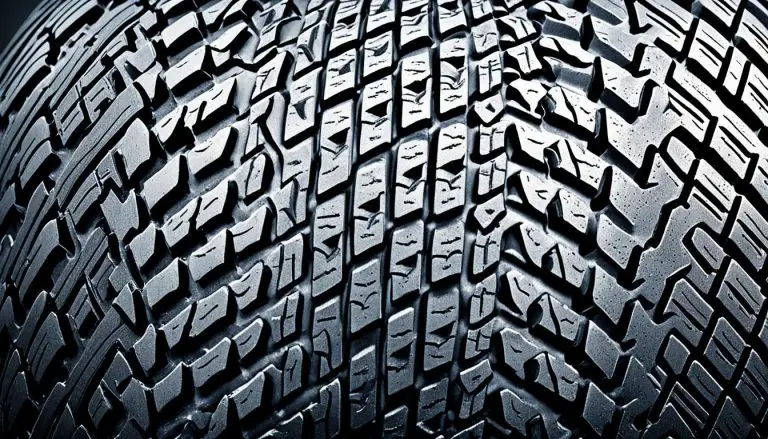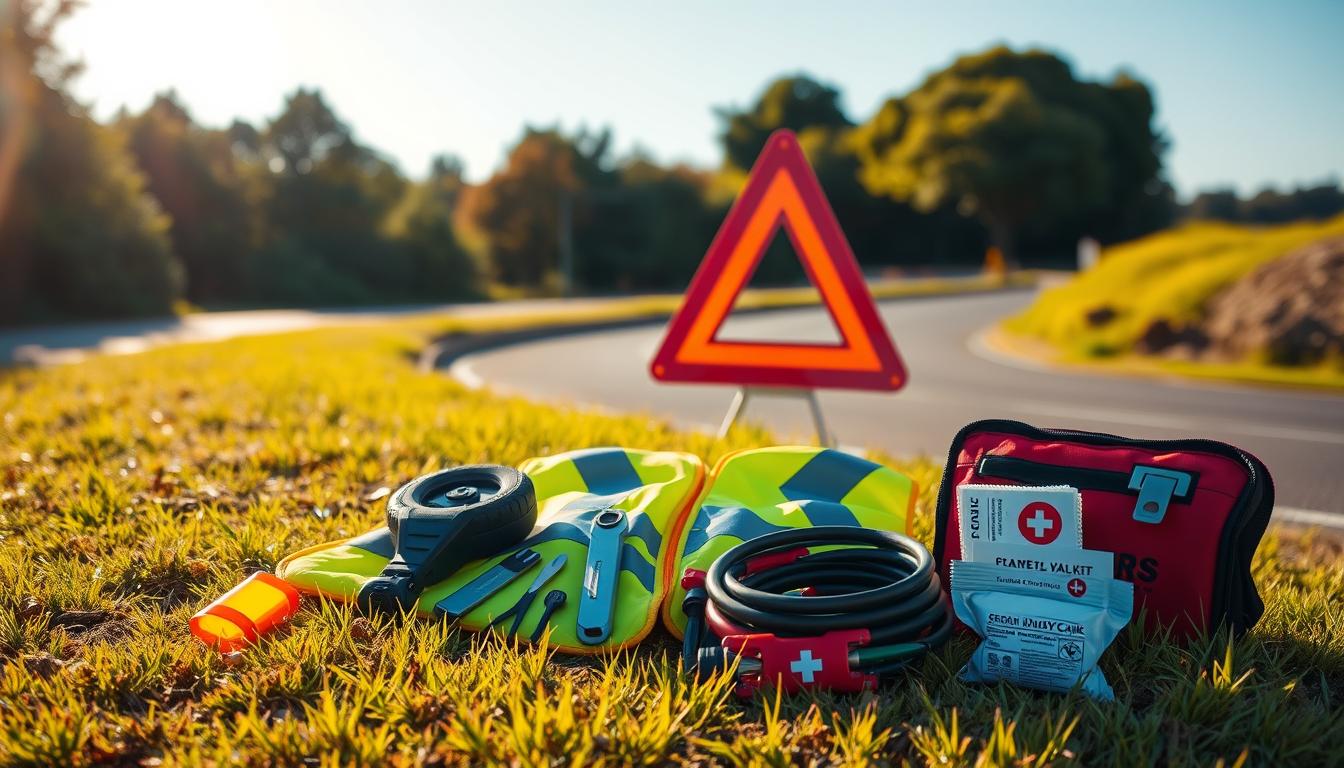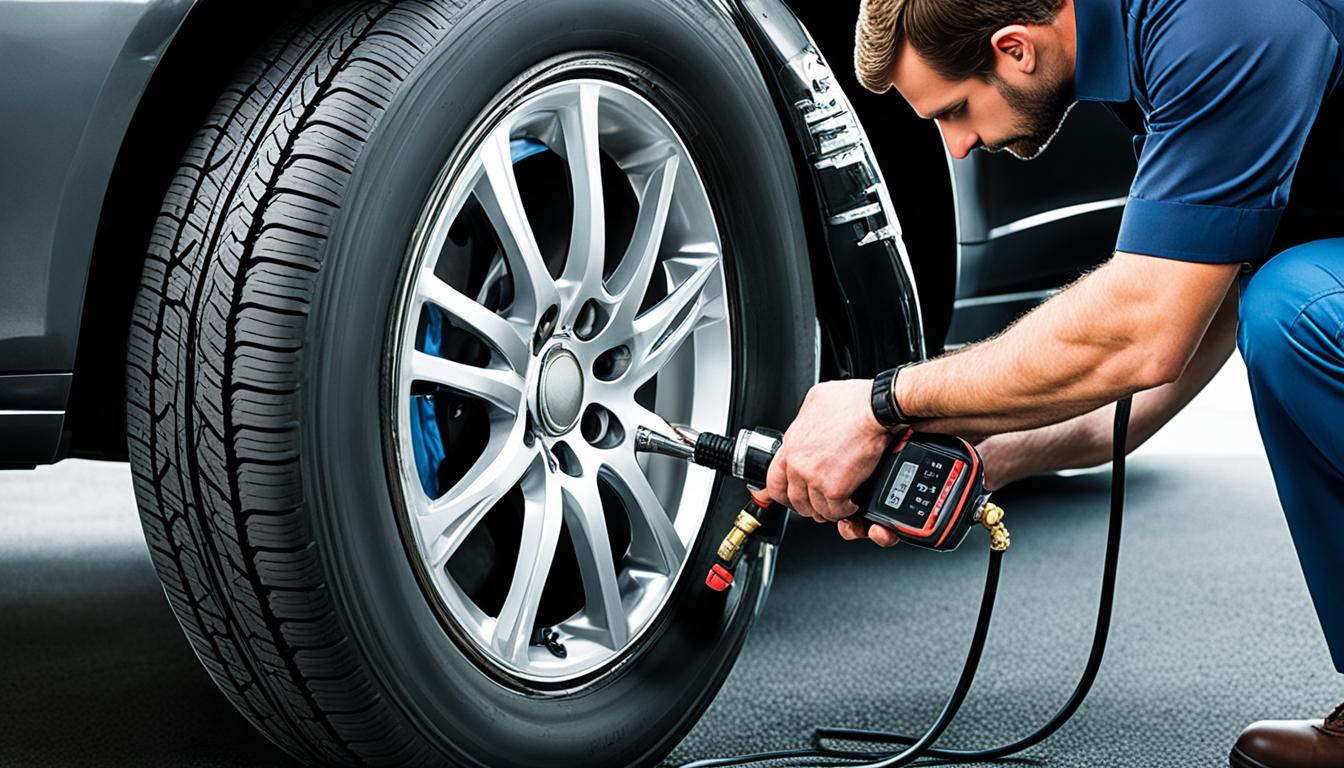
In 2022, tire-related crashes claimed the lives of 562 individuals. This number highlights the paramount importance of regular tire maintenance. Whether you drive daily or take a road trip now and then, learning to care for your tires improves both safety and performance.
Keeping the correct tire pressure plays a vital role in your car’s overall safety and performance. Tires that are underinflated cause poor fuel economy and wear out unevenly. Conversely, overinflated tires lower traction, increasing the chance of a blowout. It’s crucial to also regularly perform tire rotations, wheel alignments, and tread depth inspections for longer tire life and a smoother, safer drive.
Understanding Proper Tire Pressure
It’s critical to keep your tire pressure just right for safety, how well your car drives, and how long your tires last. The right inflation means your car will handle better, use less fuel, and its tires will last longer. But too many drivers seem to forget about this, which often causes problems later on.
Why Tire Pressure Matters
Letting your tires get too low can make them hot and stressed. This can lead to weird tire wear and damage inside. Likewise, too much air makes tires easier to cut or puncture. The right pressure keeps your car in control, saves gas, and stops the tires from wearing out fast.
Finding the Right PSI for Your Vehicle
Each car has a specific tire pressure it should have, preferably in pounds per square inch (PSI) or kilopascals (kPa). You can find this in the owner’s manual or on your car’s driver door. It’s crucial to meet these specifics for your car’s unique needs.
| Tire Pressure Recommendations | Minimum | Recommended | Maximum |
|---|---|---|---|
| Compact Car | 28 PSI | 30 PSI | 35 PSI |
| Midsize Car | 30 PSI | 35 PSI | 40 PSI |
| Full-size Car | 32 PSI | 35 PSI | 42 PSI |
| SUV | 35 PSI | 40 PSI | 45 PSI |
| Pickup Truck | 35 PSI | 45 PSI | 50 PSI |
The max pressure on a tire’s sidewall is not for everyday use. You should keep your tires at the pressure recommended by the car maker. This way, your car will perform well, be safe, and use fuel efficiently.
Make sure to check your tire pressure often and maintain it correctly. This simple step can prevent lots of problems, from bad steering to extra wear and tear. By recognizing how vital tire pressure is and sticking to your car manufacturer’s advice, you make sure your tires are up for safe and reliable driving.
Checking Tire Pressure Regularly
Keeping the right tire pressure is key for your vehicle’s safety, handling, and fuel use. The advice is to check your tire pressure once a month, and before any long journey. Doing this will avoid problems from tires being too full or not full enough.
When to Check Tire Pressure
It’s best to check when the tires are cold. This means after the vehicle has been parked for three hours, or after driving under a mile at a slow pace. Tire pressure changes with temperature, so this ensures you get the correct pressure.
Using a Tire Pressure Gauge
A quality tire pressure gauge is needed for checking tire pressure. You can find digital and standard gauges at stores that sell auto parts. It’s best to own your gauge; this ensures its accuracy since gas station gauges might not be checked often.
Always write down the pressure you find in each tire. This log will help you stay on top of your tire pressure. Then you can adjust it as needed to match the recommended PSI levels that your car’s manual or the door jamb suggests.
https://www.youtube.com/watch?v=-HRridfF0DI
Regularly using a good gauge to check your tire pressure keeps your car driving safely and efficiently.
Consequences of Under-Inflated Tires
Maintaining the right tire pressure is key for both performance and safety. Sadly, many drivers overlook this vital task, leading to the severe outcomes of under-inflated tires. This negligence affects handling, gas mileage, and the safety of everyone on the road.
Under-inflated tires are more likely to wear out quickly or, worse, cause blowouts. Incorrectly inflated tires build up excess heat and stress, leading to uneven wear and damage. This damages a tire’s grip and handling, especially in adverse weather.
Additionally, low tire pressure can damage your gas savings. With more rolling resistance, your engine uses more energy, resulting in a 3-4% jump in fuel use for every 5 psi drop. This stress on your budget also increases your carbon footprint.
The risk is not just about tire health and gas usage. Ill-inflated tires also impact how your vehicle handles and sticks to the road, increasing the chance of accidents. Diminished traction causes longer stopping distances, complicating control in crises or on wet surfaces.
The National Highway Traffic Safety Administration reports roughly 11,000 accidents yearly are due to under-inflated tires. Many of these crashes lead to severe harm or death, highlighting the critical need for proper tire maintenance.
To keep you and your tires safe, check the pressure at least monthly with a precise gauge. Follow the recommended pressure from your vehicle’s manufacturer, commonly located on the driver’s side door or in the manual. This way, you avoid the dangers from under-inflated tires.
Emphasizing tire pressure upkeep grants you a safer, more efficient drive that lasts longer. Remember, well-inflated tires are crucial for peak vehicle performance and the peace of mind of every driver on the road.
tire pressure maintenance
Many modern vehicles come with Tire Pressure Monitoring Systems (TPMS). These systems detect when tires are 25% under-inflated and warn drivers. However, TPMS isn’t a full replacement for manual tire pressure checks with a gauge.
The TPMS light might alert you too late to avoid tire damage. Thus, making regular tire pressure inspections part of your monthly routine is key. This holds true even if your car has TPMS. Adequate tire inflation is pivotal for safety. Under-inflated tires can cause heat to build up and internal damage.
It’s wise to check your tire pressure monthly, especially when tires are cold. The inflation pressure can vary by 1-2 pounds for every 10-degree temperature change. Over-inflated tires might sustain damage when hitting potholes.
In the U.S., all vehicles made post September 2007 had to include TPMS. These systems use either valve-stem or band-mounted sensors. Incorrect sensor positioning or using the wrong valve-core can damage the sensor or lead to system malfunctions.
After tire service, making sure the TPMS is correctly re-programmed is crucial. This might need specialized equipment, depending on your car. Under Federal law, turning off the TPMS is illegal. Its replacement is only allowed for after-market wheels that don’t fit the original sensor.
Key Takeaways:
- TPMS alerts drivers when tires are 25% under-inflated, but should not replace regular monthly pressure checks
- Proper inflation pressure is crucial for tire safety, with both under-inflated and over-inflated tires posing risks
- Tire pressure should be checked at least once a month when tires are cold, and before long trips or heavy loads
- TPMS systems use valve-stem or band-mounted sensors, which require proper handling during tire service
- Re-programming the TPMS may be necessary after any tire service, using specialized equipment
Handling Over-Inflated Tires
Under-inflated tires are a well-known danger, but it’s vital not to overlook the risks of over-inflation. Tires that exceed recommended pressure levels become more prone to tears, punctures, and road damage. They are also less effective in providing grip, especially on wet or slippery roads.
When tires are over-inflated, they face a higher chance of blowouts. Such events can lead to a loss of control and a need for longer braking distances. Moreover, driving on overinflated tires may be uncomfortable due to increased rigidity, which affects the ability to handle road bumps. It also accelerates wear, causing tread at the center to wear faster.
Keeping your tires within the manufacturer’s specified pressure range is key for safety. Routine pressure checks, especially before extended drives or if temperatures shift significantly, are important. This practice helps steer clear of the dangers of over-inflation.
| Potential Risks of Over-Inflated Tires | Recommended Actions |
|---|---|
|
|
Adhering to these guidelines will significantly reduce the risk of over-inflation in your tires. Doing so not only enhances your safety on the road but also contributes to optimal tire performance.
Tire Rotation: Extending Tread Life
Ensuring even tire wear is key to longevity. Rotating tires distributes wear on all four evenly. This practice enhances both the performance and lifespan of tires.
Recommended Rotation Intervals
It’s advisable to rotate your tires every 5,000 to 7,000 miles. This typically aligns with regular oil changes. By doing so, you prevent uneven wear and maintain tire health. According to studies, this can boost tire lifespan by more than 30%.
Rotating Directional Tires
Tires with directional tread patterns are specifically designed for forward movement. Thus, they should rotate in only one direction. A professional service center should handle rotating such tires. Incorrect handling could compromise safety and performance. Improper rotation of directional tires may lead to issues.
Tire rotation is a straightforward yet impactful maintenance practice. Adhering to the recommended intervals and patterns significantly elongates tire life. This commitment ensures you enjoy a smoother and safer drive over an extended period.
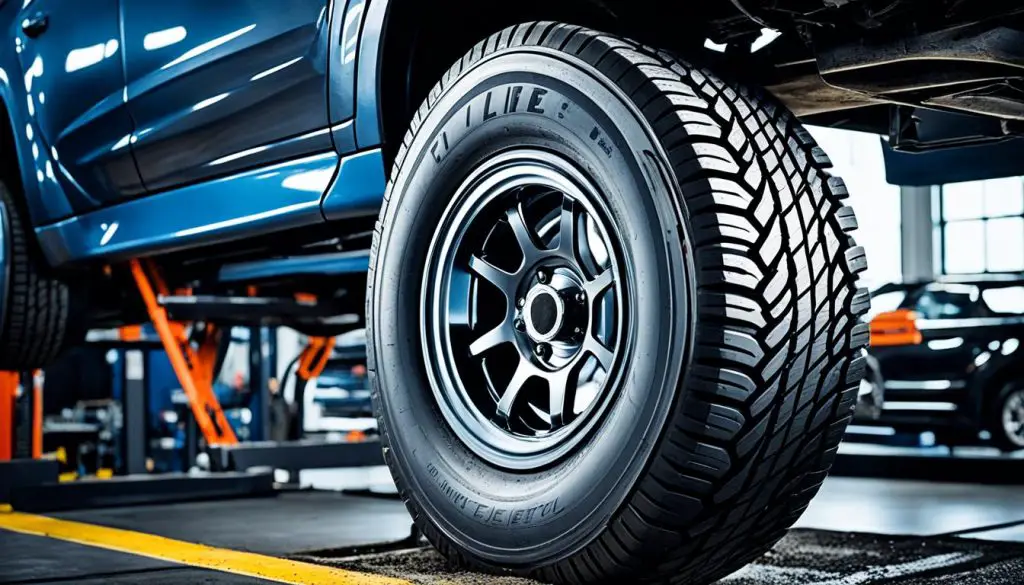
For further insight into the advantages of regular tire rotation and its role in enhancing your car’s performance, consider these sources:
- How to Make Your Tires Last
- Tire Rotation: Why It’s Important and How to Do It
- The Benefits of Regular Tire Rotation: Extending Tire Life and Improving Safety
Wheel Alignment for Even Wear
Proper wheel alignment is vital for maintaining a vehicle’s condition, affecting tire wear, handling, and driving quality. It entails adjusting wheel angles to meet the manufacturer’s specs, making sure they are both perpendicular to the ground and parallel to each other. This precision results in even tire wear, better handling, and less pressure on the suspension.
Incorrect wheel alignment may bring about various problems, such as uneven tread wear, a car pulling to one side, and more stress on the suspension parts. It’s wise to check your alignment every 4,000 to 6,000 miles, or if you observe signs of trouble like uneven tire wear or drifting to one side.
The alignment process zeroes in on three critical angles: camber, toe, and caster. Camber looks at the wheel’s vertical tilt, toe at their rolling direction, and caster at steering and weight distribution. All must be correct for optimal performance.
| Alignment Angle | Description | Impact on Tire Wear |
|---|---|---|
| Camber | The inward or outward tilt of the tire from the front | Excessive camber can cause uneven “feathering” or “camber wear” on the tire tread |
| Toe | The alignment of the tires when viewed from above | Toe misalignment can lead to “heel/toe wear” on the tire tread |
| Caster | The steering axis angle when viewed from the side | Improper caster can contribute to uneven tire wear and impact vehicle handling |
Several factors can cause misalignment, such as environment, personal driving habits, and suspension wear. Performing regular checks and alignments is key for uniform tire wear, excellent vehicle handling, and safe driving.
Good tire care, like checking pressure, inspecting treads, and rotating every 5,000 miles, can prevent misalignment and prolong tire life. By ensuring proper wheel alignment, you not only enjoy a smoother and safer ride but also make the most of your tire investment in your vehicle.
Balancing Tires for Smooth Rides
Maintaining proper tire balance is key for a comfortable, safe drive. With time, tire weights can shift unevenly due to wear, causing vibrations and wear. The balancing process, applying small weights, evens out this distribution. This leads to a smoother drive and longer tire life.
Signs of Unbalanced Tires
High-speed vibrations, felt at 50 mph or above, often signify tire imbalance. You might also see cupping or scalloping patterns on the tires. These patterns are clear signals of balance issues.
Balancing when installing new tires, after a repair, or if vibrations occur is wise. Regular tire balancing promotes even wear, extends tire life, and ensures comfort.
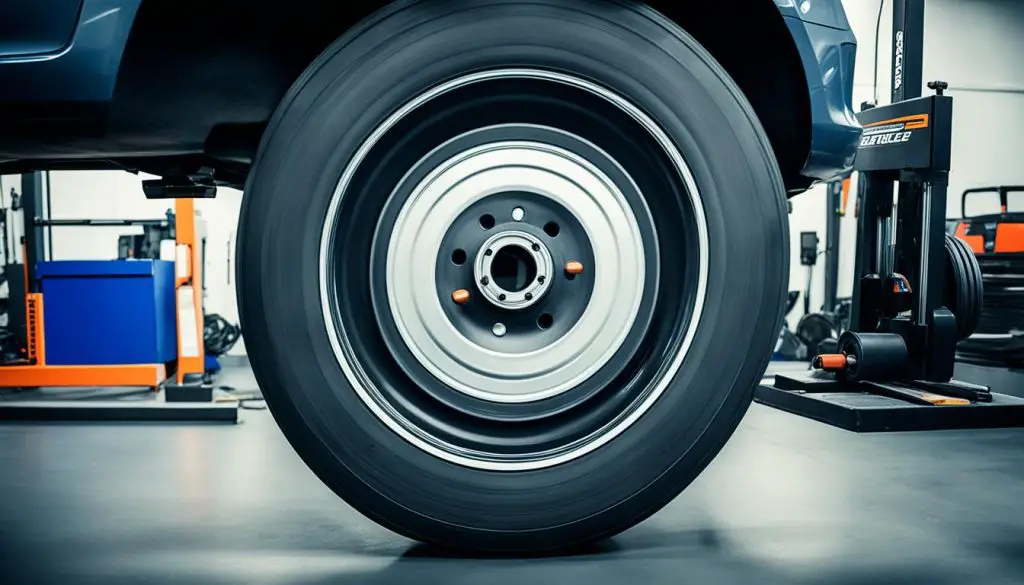
| Recommended Tire Balancing Intervals | Benefits of Proper Tire Balancing |
|---|---|
| Every 5,000 to 7,000 miles |
|
Keeping wheel balance means a safer, more comfortable drive and longer tire use. Don’t forget this crucial maintenance step.
Inspecting Tread Depth
Maintaining appropriate tire tread depth is vital for your vehicle’s safety and how well it drives, especially in slippery conditions. You can easily check tread depth with the penny test.
For the penny test, place a penny into the tread groove with Lincoln’s head facing down. If you see the top of his head, it means your tires should be replaced. Newer tires come with tread wear indicators. These are small, elevated bars inside the tread grooves. If these bars are level with the tire’s outer layer, your tires are too worn.
A more accurate check can be done with a tread depth gauge. This ensures your tires meet the minimum tread depth, usually 2/32 of an inch. Keeping an eye on your tire tread depth is key to ensuring your car keeps its grip and you stay safe.
| Tread Depth | Condition | Recommendation |
|---|---|---|
| 4/32 inch or less | Severely worn | Replace tires immediately |
| 4/32 to 6/32 inch | Moderately worn | Consider replacing tires soon |
| 6/32 inch or more | Good condition | Tires are safe to continue using |
By checking your tire tread regularly and swapping out worn tires, you enhance your road safety and driving experience. Always choose safety first regarding your tires.
Conclusion
Your tires play a critical role in not just your vehicle’s performance, but also its safety and efficiency. It’s crucial to prioritize tire care. This includes checking tire pressure often, rotating your tires, aligning your wheels, and keeping an eye on tread depth. By doing this, you can extend your tires’ life, ensuring your vehicle runs smoothly for longer. Remember, maintained tires boost vehicle safety and fuel efficiency, saving you money over time.
Keep on top of your tire maintenance for peace of mind. It shows you care about having your vehicle in its best possible condition. Northeast Auto Service in Indianapolis, Indiana, can help. Their team offers top-notch car maintenance and repairs. With their assistance, your tires will be in excellent shape, and your vehicle will perform its best.
Regularly caring for your tires is a decision that pays off big in many ways. It improves your driving, saves you money, and helps the planet. Give your tires and vehicle the attention they deserve. You’ll enjoy safer, more efficient, and pleasurable driving experiences.
FAQ
Q: Why is maintaining proper tire pressure important?
A: Keeping the right tire pressure is crucial for safe and efficient driving. Low pressure can waste fuel and wear tires unevenly. High pressure limits traction and may cause a blowout.
Q: How do I find the recommended tire pressure for my vehicle?
A: Look in your car’s manual or the driver’s side door jamb for the PSI recommendations. Maintaining proper pressure is key for control, saves fuel, and delays tire wear.
Q: How often should I check my tire pressure?
A: Since a tire loses air over time, check pressures monthly or before trips. Always use a gauge on cold tires for accurate readings.
Q: What are the consequences of under-inflated tires?
A: Low pressure causes tires to overheat and wear out strangely. This harms traction, especially in poor conditions, and uses more gas.
Q: How do Tire Pressure Monitoring Systems (TPMS) work?
A: TPMS in newer cars warns if tires are 25% under-inflated. Yet, manual checks are still needed to avoid unexpected tire damage.
Q: What are the risks of over-inflated tires?
A: Too much air makes tires prone to damage when faced with bumps. It also hinders their grip, especially when it’s wet or slippery.
Q: How often should I rotate my tires?
A: Tire rotation every 5,000 to 7,000 miles is wise, typically when you change oil. This keeps wear even, extending tire life and enhancing performance.
Q: Why is wheel alignment important?
A: Aligning wheels correctly aids in even wear and better vehicle handling. Poor alignment leads to uneven wear, vehicle pull, and extra suspension stress.
Q: What are the signs of unbalanced tires?
A: Unbalanced tires show up as strong vibrations at higher speeds and worn spots on the tread. Balancing irons out these issues, ensuring a pleasant drive and longer tire life.
Q: How do I check my tire tread depth?
A: For tread checks, use the penny test or look for tread wear bars. If Lincoln’s head is visible, or if these bars are level with tread, it’s time for new tires.
